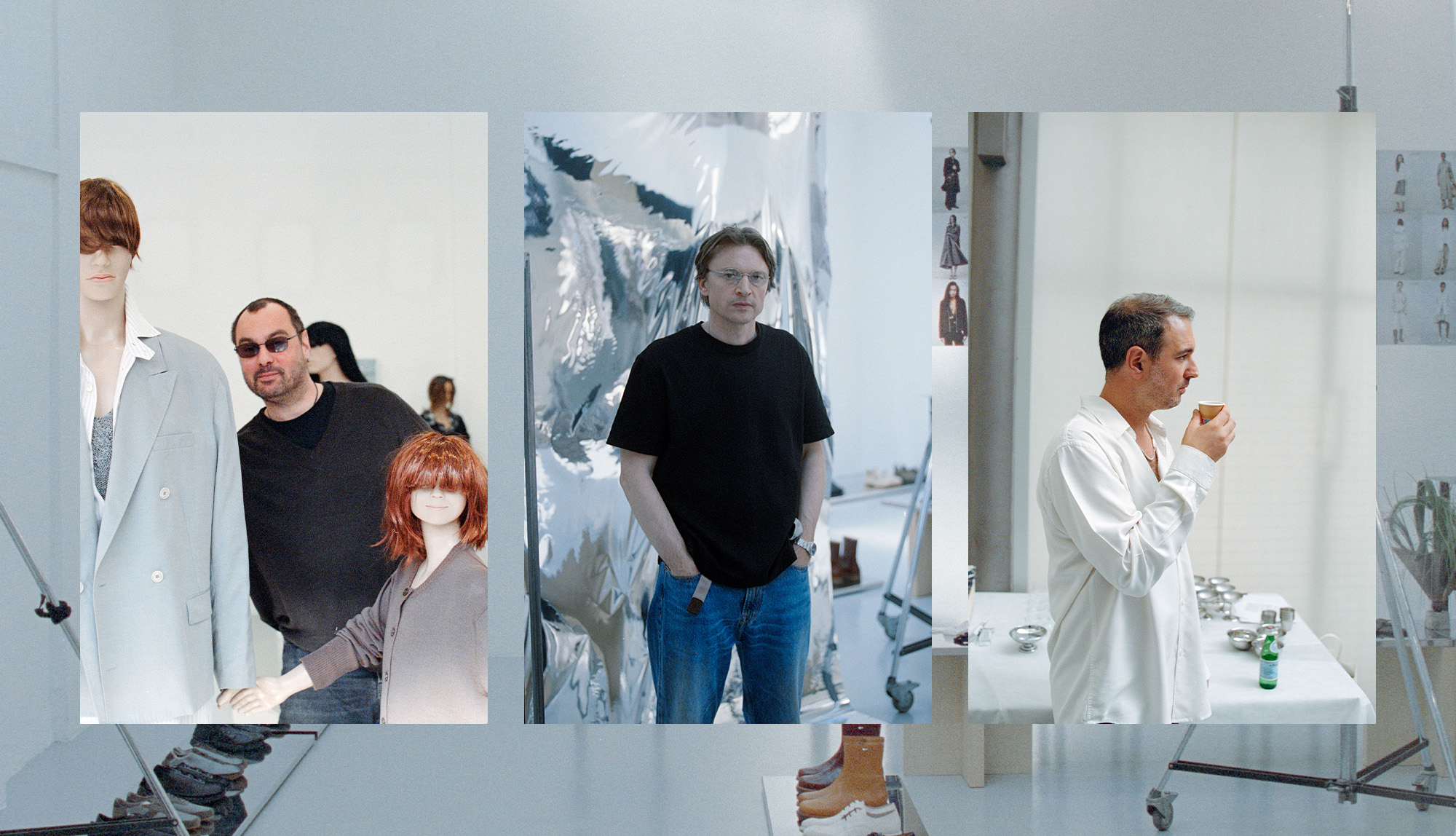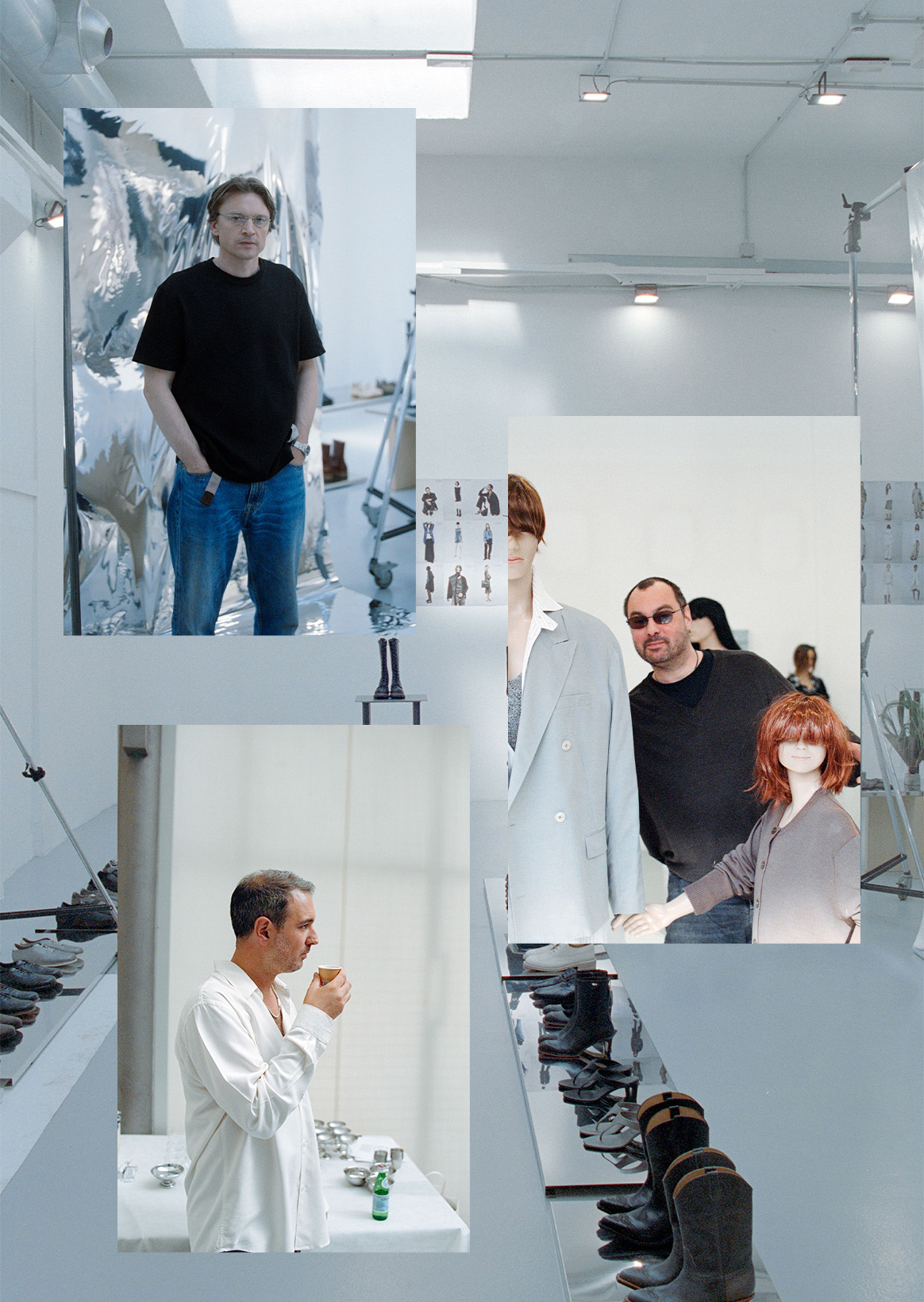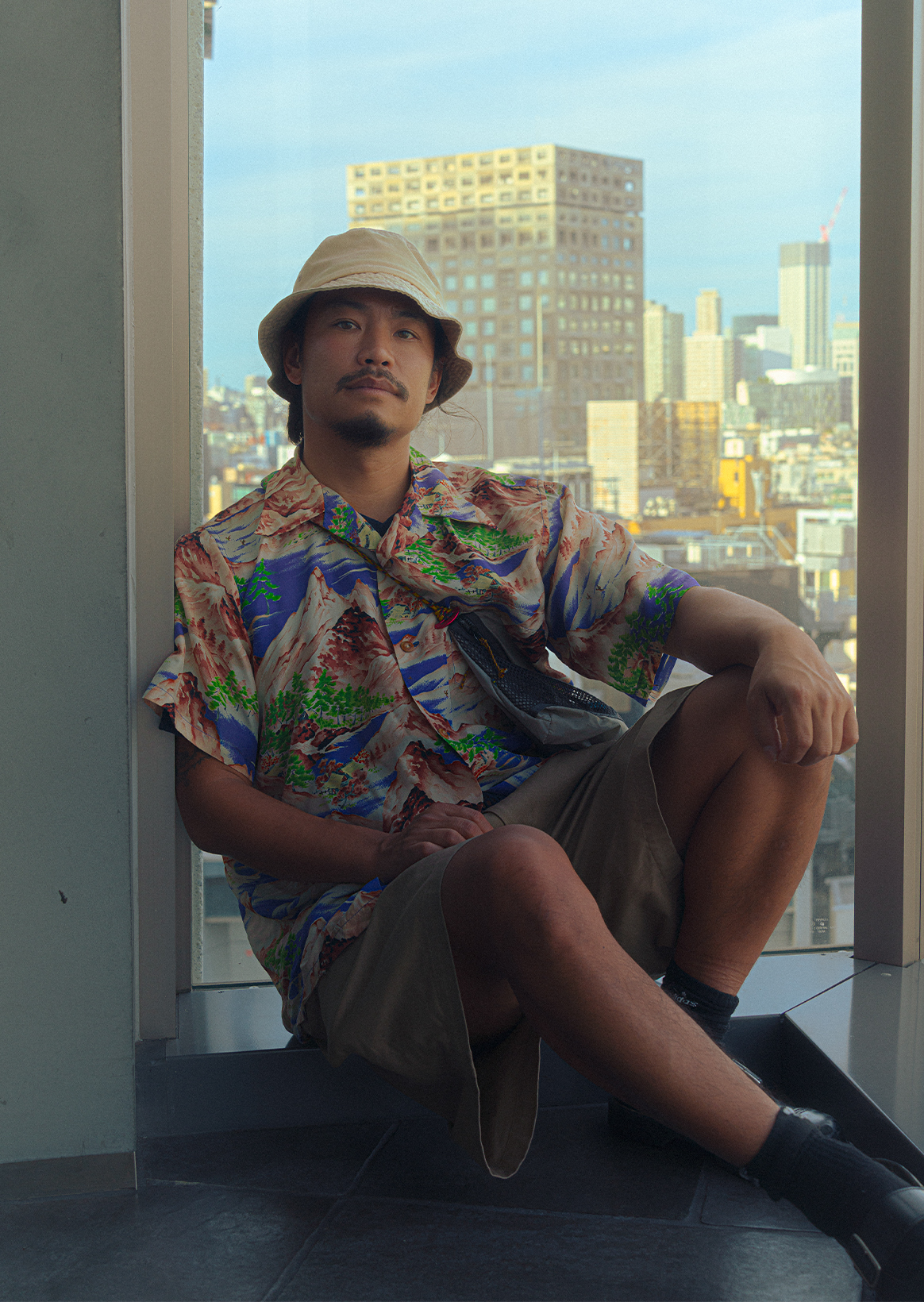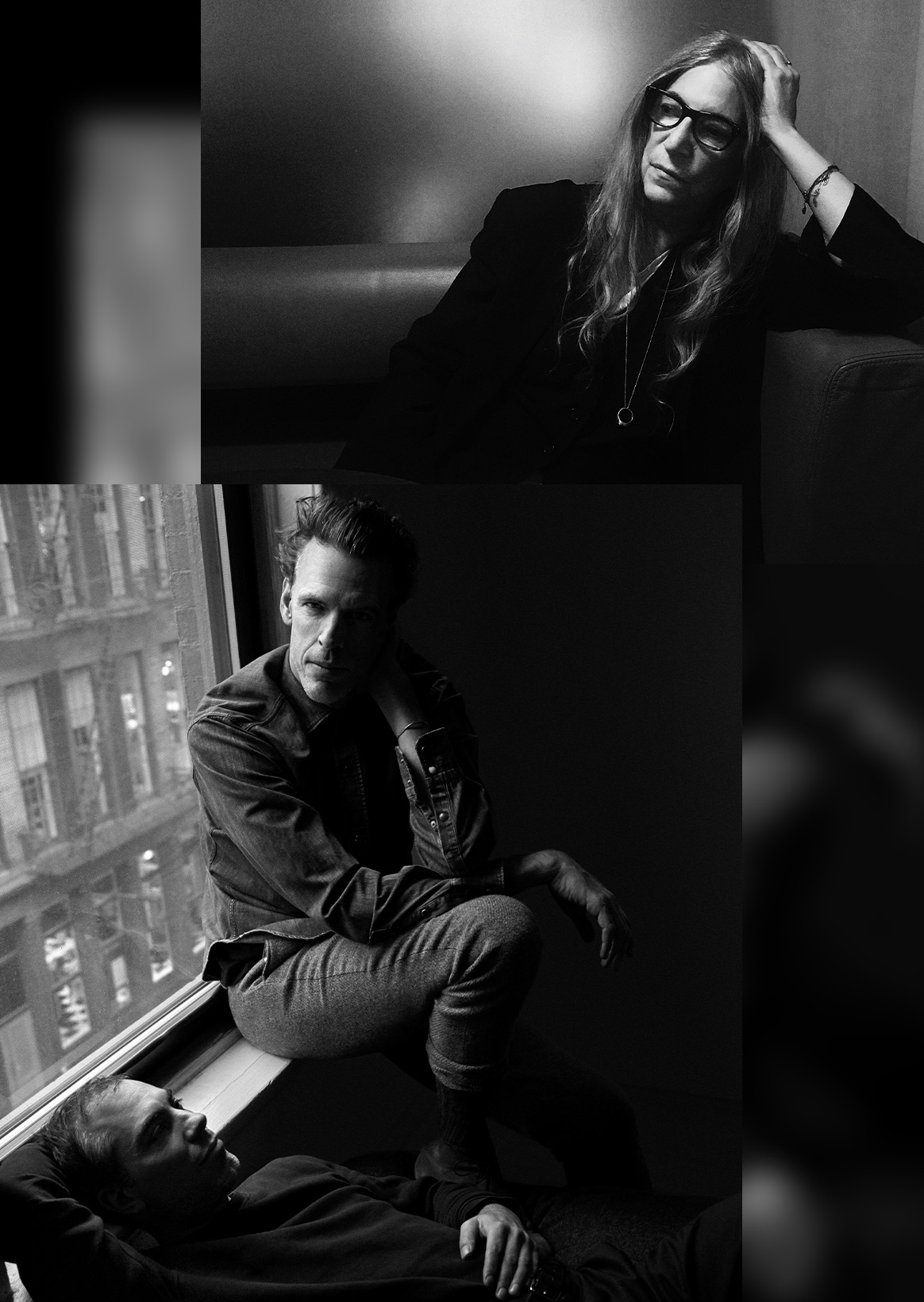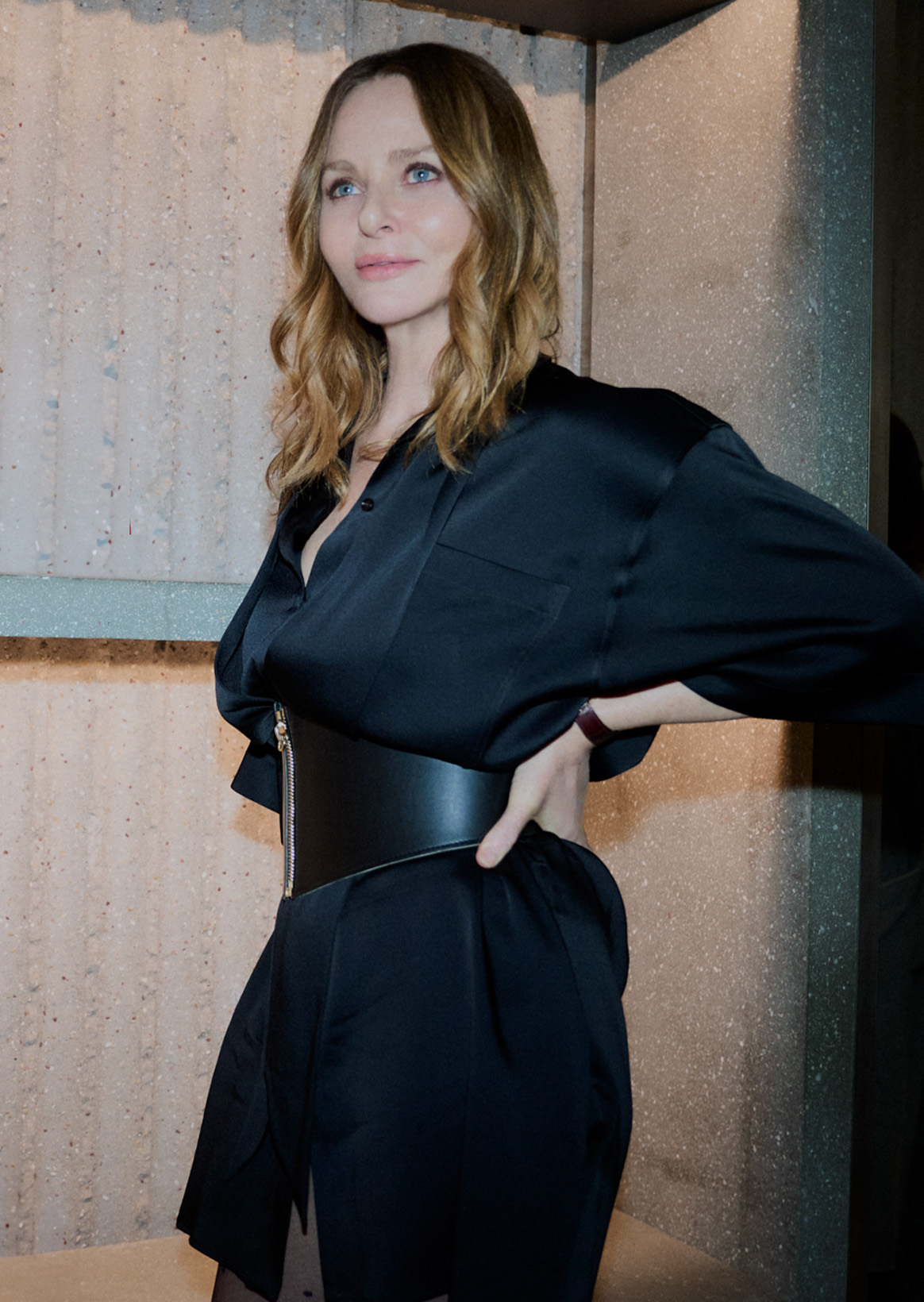10多歲的時候通過冰球相遇並成為朋友的約克姆·哈林和克裡斯托弗·尼英,2005年在斯德哥爾摩成立了“OUR LEGACY”,不久之後理卡多斯·克拉倫作為共同經營者加入。近20年來,受音樂、滑板和藝術書籍等街頭文化的影響,感性超越了現有時尚的框架,不斷創造探索可持續性的表達方式。2025年6月13日,在澀谷PARCO 2樓盛大開業了日本第一家商店in Shop。從2016年開始,考慮到可持續性,WORK SHOP的專案也在展開,再利用死庫存、樣品和再利用材料的專案。通過服裝的表現,創造的原點,以及從東京得到的靈感——。在這次的郵件採訪中,我們將揭開他們的歷程和對創造的哲學。
※ The English version is available below.
- Photo
- Nils Junji Edström
- Text
- Tomoko Ogawa
- Edit
- RIDE Inc.
 Jockum Hallin
Jockum Hallin  Cristopher Nying
Cristopher Nying  Richardos Klarén
Richardos Klarén
——約克姆·哈林和克裡斯托弗·尼恩在10多歲的時候通過冰球相遇的時候,彼此都有什麼樣的印象呢? 如果當時度過了怎樣的10多歲,現在還殘留在自己心中的部分的話,請告訴我。
13歲時與 約克姆·哈林(以下簡稱約克姆)克裡斯托弗相遇。在少年的冰球練習中,太擅長的他,升格為我年長的隊伍。我是1980年出生的,他是1981年出生的,所以年齡很近,但是那個時候的我已經沉迷於音樂、滑雪板、滑板等塑造自己的東西,漸漸遠離曲棍球。我自己開始打曲棍球很晚,為了抓住住處拼命努力著吧。另一方面,克裡斯托弗作為一顆充滿能量的新星來到了球隊。這種態度現在也是一樣的。見到他的人,一定會被他的毅力、能量和好奇心所震驚。他是一個不斷前進的人,從以前開始就沒有改變。
克裡斯托弗·尼恩(以下簡稱克裡斯托弗)一起打曲棍球,第一次見面是在巴士裡。約克姆是一個沉穩、帥氣、沉迷於音樂的時尚人,這是他最初的印象。這種印象一直沒有改變。
——第一次感受到創造的喜悅是什麼樣的時刻?
克裡斯托弗最初是畫油畫,製作雕刻的。關於西服,16歲的時候,在當地的福斯克瓦納和朋友一起實驗牛仔褲是開始的。用繩子把牛仔褲系在車後面,拖在泥上造成了傷害。之後,穿著牛仔褲洗了澡,進了桑拿晾乾了。我至今還記得當時的興奮感。
ー對於通過衣服向他人說明、表達自己的重要性,你是怎麼想的?
在喬克姆年輕的時候,衣服在尋找自己的身分和住所方面起著很大的作用。衣服不需要說明,可以代表自己。這樣一來,人就會靠近或離開,成為尋找朋友和朋友的契機。長大後,衣服仍然是自我表現的手段。你是想給你看一個整潔的人,還是想讓你自由、有創意的人看?衣服是一個強大的工具,這一點沒有改變,但是隨著年齡的增長,他們的關係也在一點點地變化。
——你認為為了繼續實現自己真正想做的事情,需要什麼? 另外,為了成為能夠做到這一點的自己,鍛煉了你的經驗是?
克裡斯托弗對我來說,平面設計是一個很大的入口。學會了往返於物理製作和數字製作之間,這種平衡感成為了使形象成形的手段。這在製作衣服和用視覺表現感情的時候也很有用。而且,總是給我刺激的是書。特別是藝術書籍和寫真集,自古以來就一直讓我興奮不已。
——千奈美培育自己的藝術作品是? 那時候,你喚起了什麼樣的感覺呢?
克裡斯托弗馬塞爾杜尚的作品捕捉方式受到了很大的影響。他對作品非常有情感,其自由令人印象深刻。當斯德哥爾摩的策展人複製在紐約發表的作品時,他不但生氣,反而肯定地說“不是很好嗎?”誰都可以複製自己的作品這樣的想法,雖然引起了爭議,但還是非常開放的思想。簽名的代表作“R.Mutt”的馬桶很有名,笑起來,但是他自己最喜歡的是在展示中沒有人注意到的梳子。受到了這種沒有邊界的強烈影響。現在也提醒我對創作的自由態度。



我認為,正因為OUR LEGACY以擁有不同背景的成員而不是時尚,所以在時尚行業中,我們已經建立了一個既是塑膠又獨特的、漸進的、可持續發展實驗的場所。繼續建立這樣的場合的秘訣是什麼?
我想 約克姆正是那樣。公司長大後,階級鑰匙和決策的結構是必要的,但是我們同時重視開放民主的工作方式。不是誰想的,而是經常保持著“最好的想法獲勝”的姿態。氣氛非常放鬆,是一個家庭式的職場。互相幫助,愉快地工作。因為時尚很有趣。服裝、食物、葡萄酒、體育、藝術、攝影、音樂……能被那樣的東西包圍著工作真的很幸福,那個快樂表現在公司的氣氛和夥伴意識上。
在變奏曲中,哪些是靈感的源泉?
克裡斯托弗通常是從衝突中產生的。有些東西走投無路,可是突然一瞬間想起了想法。洗澡的時候或者做飯的時候突然,感覺很沉迷。不要錯過那一刻。接下來是藝術書籍和寫真集。從以前開始就讀過好幾次同一本書,每次都會有新的發現。不是在尋找,而是自然而然的。對我來說,創造性並不是強迫創造出來的。
——從開始WORK SHOP以來,OUR LEGACY的重要舉措之一,您學到了什麼? 請讓我聽聽在推進約10年“儘量不扔垃圾就做衣服”哲學的過程中面臨的課題和新的發現。
約克姆WORK SHOP對我們來說是非常重要的,是OUR LEGACY生態系統中不可或缺的一部分。主線和WORK SHOP相互起作用,其中一方是不成立的。最大的挑戰是與大公司合作。我們雖然很小很輕鬆,但是大公司無論如何行動都很慢。好像是把油輪換個方向。但是我們堅持不懈地努力著,這種態度會給合作夥伴企業帶來積極的影響。活用現有的材料,找到新的可持續解決方案是很難的,但相應地有很大的價值。

雖然在硅石、紋理和衣服中有過去的記憶,但OUR LEGACY似乎通過“重新詮釋”創造了新的背景。對於懷舊和非懷舊的平衡您是怎麼想的?
克裡斯托弗我自己也不覺得太懷舊了。也許這是穿衣服的人和看的人所感受到的吧。對我來說,收集真正喜歡的東西並持續持有的感覺更近了。例如,在2026年春夏系列中,我們製作了一件夾克,該夾克最初購買的年份物品。那是在從事時尚之前,只是因為喜歡所以才買到的米利塔莉的連衣服。只剩下上半部分就剪掉了。雖然沒有特別懷舊的意義,但是根據人的不同可能會感受到懷舊感,新一代可能會有完全不同的看法。對我來說,現在是誠實地重新詮釋,而不是再現過去。
——雖然有創意總監、設計師、CEO等角色分擔,但是如何很好地三個人一邊保持平衡一邊協作呢?
我和 約翰一起做了20多年,但是我覺得角色明確是很大的。每個人都可以在自己的領域自由活動,同時擁有獨立性。正因為如此,才不走得太多,取得了很好的平衡。但是同時,也有交往的重點,也有一起作為隊伍向同一方向前進的瞬間。更重要的是,我們只有三個人才是我們的優勢。如果只有兩個人的話,意見會破裂而停滯不前,但是有三個人的話一定能做出決斷。有時也會有錯誤,但無論如何都要向前走。
裡卡多斯·克拉倫(以下簡稱裡卡多斯)一起工作了20年,而且在那之前也是熟人,非常容易做。從根本上講,我們是朋友,有著相同的價值觀,有著怎樣建立品牌、每天如何工作的共同願景。審美意識有時會有所不同,但這也是一種很好的刺激。而且,整個公司的團隊合作也很自然,很舒服。大家朝著同一個方向互相合作,我覺得這是我們的堅強。


我們在許多專案中進行合作,您需要什麼是合作夥伴?
約克姆我們所追求的是讓人興奮的存在。不是像自己的鏡像那樣的對象,而是給予我們新視點的人和東西。無論是體育品牌、廚師、葡萄酒生產商,還是音樂家、家具公司都可以。即使在自己沒有直接關係的領域,從能感受到熱情的東西中也受到了強烈的靈感。
在ー斯托克霍爾姆的背景下,它成為了一個受到全球好評的品牌,您是怎麼看待“本地”的重要性的呢?
克裡斯托弗瑞典不是一個時尚的國家。產業規模也不大,反而可以集中在自己的世界裡。雖然在東京時尚的存在感非常大,但是在瑞典很安靜,可以帶入自己的做法。就我個人而言,我並不覺得是瑞典式的。我不是來自斯德哥爾摩,而是來自福斯克瓦納,塑造我的旅程更是如此。所以所謂“地方”,是指雖然是出生地,但如何隨身攜帶的視點。
——就像從計程車文化中汲取靈感的手工製作的獨特和平一樣,特別是從東京澀谷這個城市得到的靈感的話,請一定要告訴我。另外,如果有個人的回憶和印象的話,我想聽聽。
約克姆罕默德的作品構思於芬蘭家具品牌Artek與瑞典鉤針編作家合作,在東京計程車上看到的賽車座椅罩。如果幸運的話就能遇到那個美麗的封面。東京,特別是澀谷,每次去都會有新發現的城市。光是表面就足夠開心,但是去了好幾次的時候就能感受到一點點剝落層的深度。我覺得這種探索和發現的感覺是東京特有的魅力。與其說是具體的回憶,不如說是小小的發現的積累。有人對我說“這個舊衣服店很好”、“這個壽司店最棒了”、“看看這個展示”,我在地圖上迷路了,在建築物的10層、地下、普通公寓的一個房間的裡面、洗衣房的後面等等。跪著穿過小門,就會發現魔法般的空間。沒有其他能體驗到那樣的城市,所以我每次去東京都會感到同樣的興奮。
克裡斯托弗澀谷的有趣之處在於混雜在一起。既有工匠技術,也有技術和未來,感覺5個街道被塞進了一個街區。在那裡迷路是很開心的。第二次去東京旅行的時候,去了“悠閒橫丁”的時候,被70歲左右的日本男性搭話,一起度過了夜晚。帶我去吃飯,爬上酒吧,最後送到了飯店。雖然是完全的初次見面,但是非常親切和友好,那個體驗至今難忘。
我喜歡 裡卡多斯澀谷。時尚、文化、藝術、音樂,無論對什麼感興趣都能享受的地方是很多呢。當然也喜歡參觀PARCO,但是貓街周邊的復古購物也是樂趣之一。以前喜歡在鐵路下的胡同吃飯,但是最近遊客好像增加了呢(笑)。早上在代代木公園跑步,欣賞美麗的景色。之後在富谷散步,尋找美味的咖啡也不錯。然後晚上在卡拉OK結束。如果是樓上的樓層的話,到處都是最棒的夜晚!

Jockum Hallin and Cristopher Nying first met as teenagers through ice hockey, a friendship that later led them to establish OUR LEGACY in Stockholm in 2005. Richardos Klarén joined as co-founder, and together they have cultivated a sensibility shaped by nearly two decades of immersion in street culture —through music, skateboarding and art publishing. Their work has steadily moved beyond the usual boundaries of fashion, pursuing sustainability while creating a distinctive form of expression. On 13 June 2025, they opened their first space in Japan—a shop-in-shop on the second floor of Shibuya PARCO. Alongside their mainline collections, the store also features WORK SHOP, the ongoing project they began in 2016 that reuses deadstock, samples and recycled materials. Clothes as a form of expression, the origins of creativity, and the inspiration they have found in Tokyo—these are the themes we explore in this email interview.
――This question is for Jockum and Cristopher. When you first met as teenagers through ice hockey, what impressions did you have of each other? What kind of kids were you back then―and what parts of that still remain in you today?
Jockum: I met Christopher during junior ice hockey training when we were about 13. He was so good that he had to move up and play with an older team - my team. I was born in 1980, and he was born in 1981, so we weren’t that far apart, but I was just getting into things that really shaped me: music, snowboarding, skateboarding. I was on my way out of hockey, while he was just coming in. I started playing hockey quite late, so I had to fight to earn my place. Christopher, on the other hand, came in as this young star full of energy on the ice, and I feel that’s still with him today. I think people that meet him are impressed with his persistence, energy and curiosity. He just keeps on going - always pushing—and that’s something that’s really stayed with him.
Christopher: We played hockey together, and the first time I actually met him was on a bus. Jockum was this calm, good-looking guy with a cool style who was always into music. That first impression of him has really stayed with me.
――Could you tell us about your first memory of experiencing the joy of creation?
Cristopher: I started out painting with oils and making sculptures. With clothing, I was sixteen and me and my friend took a pair of jeans to a parking lot in Huskvarna, where I grew up. We tied a rope to the car and dragged our jeans in the clay and then we went home and showered in them and then we sat in the sauna for them to dry. That moment was the first memory of experimenting and I remember the excitement me and my friend had from that experience.
――What are your thoughts on the importance of explaining and expressing who you are to the others through clothing?
Jockum: As you go from young person to teenager to young adult into adulthood, I think clothing has different ways of being important in your life. When you are young, it’s often about identity and finding your place. For me it’s such a direct and effective way to show who you are, without any explanation. Your surrounding can easily gravitate towards or from you which in turn helps you find your group, your band mates, your friends. As you get older, clothing still allows you to express yourself - whether you want to come across as sharp and reliable or more free and creative. It remains a powerful tool, even if your relationship to it changes over time.
――What do you think is essential to keep doing what you truly want to do? And what experiences have shaped or strengthened you to be able to do that?
Cristopher: For me, graphic design was an important entry point. It taught me how to move between physical creation and digital creation. That balance became a tool for me to visualize things—something I still use everyday, whether it’s making clothes or visualizing a feeling. But something that always kept me excited and kept me doing what I do is books; art and photobooks always keep me inspired.
―― Is there a work of art that shaped you in a lasting way? What kind of feeling did it awaken in you?
Cristopher: Maybe Marcel Duchamp and the way he viewed his own work. I’ve always loved how he approached art conceptually. There’s this story about an artwork he created in New York—if I remember correctly, a curator from Stockholm, possibly Pontus Hultén (though I might be wrong), ended up copying it. But instead of being upset, Duchamp actually encouraged it. His idea was that anyone could replicate his work—you just needed to confirm and sign it, and then it was yours. It’s a controversial concept, but also incredibly open-minded. One of the most iconic examples is the urinal he signed “R. Mutt,” which is just hilarious. And his personal favorite piece? A pet comb that no one even noticed during the exhibition. That became his favorite simply because it went unseen. I think what really stuck with me is that sense of freedom and openness—that there are no real boundaries in creativity. It’s a mindset that continues to inspire me.
―― I think that the unique strength of OUR LEGACY comes from having team members with diverse backgrounds outside of the typical fashion industry. Perhaps it’s this perspective that allows you to create a space within the fashion industry that is pragmatic, unique, progressive, and open to experimenting with sustainability. What do you think is the key to maintaining such a space?
Jockum: This is a very good and very on-point question, it really identifies elements that define Our Legacy and make it such a special place to work at. In a growing company, there has to be some hierarchy and someone who can make decisions, but at the same time, we believe in a more open and democratic way of working. We try to push that mindset every day: that the best idea should always win. It’s not about who comes up with it—it’s about the strength of the idea itself. We have a relaxed, family-style way of working. We look out for each other and help each other out. It’s also a fun place to be. Fashion is fun—and whether your passion is clothing, food, wine, sports, art, photography, or music, we’re lucky to be surrounded by it every day. That joy really comes through in the atmosphere and camaraderie within the company.
―― What inspires your creative process?
Cristopher: Often it comes through struggle. You wrestle with something, and then suddenly it clicks—maybe when you’re in the shower or cooking food. You have to be quick when those thoughts come because those ideas are tough to loose. Art books and photo books have also been a big inspiration for me. I still read the same ones over and over, and every time I find new things or new angles. I’m not searching for it—it just happens, for me creativity shouldn’t be forced.
―― Since launching WORK SHOP, what have you learned along the way? How has your philosophy around minimizing waste evolved over the past almost decade, and what challenges or discoveries have shaped that journey?
Jockum: We’ve picked up and learned a lot along the way. WORK SHOP is something we’re really proud of—it’s become an essential part of OUR LEGACY’s ecosystem. The mainline and WORK SHOP exist in a kind of creative symbiosis; one really can’t thrive without the other. One ongoing challenge is working with large companies. We’ve been lucky to collaborate with some of the most respected and exciting brands in the world. Compared to them, we’re small, fast, and tactile - while bigger companies move slower. “Turning a tanker” takes time. But we’re persistent and hold firm in our approach, especially with WORK SHOP, which is more sustainability-focused. That mindset often pushes our partners to adapt in positive ways. Working with existing materials or finding new sustainable solutions is always challenging- but it comes with great rewards.
―― Your work often evokes a sense of nostalgia―through silhouettes, textures, or references―but never feels retro or sentimental. How do you think about the balance between nostalgia and non-nostalgia in design?
Cristopher: I don’t really think of myself as nostalgic. I think that feeling probably comes more from the viewer or the person wearing the piece. For me, it’s more about collecting and holding on to things I genuinely love. For example, in SS26 we made a jacket based on the first vintage piece I ever bought—way before I was even working in fashion—just because I liked it so much. It was a military boiler suit that I cut, leaving just the upper part. There wasn’t any grand nostalgic intention behind it. Maybe someone else sees nostalgia in that—and that’s fine. Maybe a new generation sees it completely differently. It’s more about reinterpreting things in a way that feels honest now, rather than trying to recreate the past.
―― Even with defined roles―creative director, designer, and CEO of OUR LEGACY―what keeps your collaboration fluid and well-balanced? What makes this trio work so well?
Jockum: It’s true, it works well. Even though we’ve been working closely together for over 20 years, our roles have always been clearly defined, and I think that’s a big part of why it works. It makes us feel independent and it gives us the freedom to work in our own field without stepping on each others toes. That said, we also have these natural intersections where we come together and feel that we are a team, where we push each other and strive toward the same direction and goal. And the fact that we’re three people is actually a strength. It means we always reach a decision. If it were just two of us, we might get stuck in disagreement and risk not moving forward at all. But with three, two will always agree, and the third has to fold. Of course, sometimes we make the wrong call, but at least we make a call and keep things moving.
Richardos: I think the fact that we have worked together for 20 years and also knew each other before that makes it easier. We are friends at heart, have a lot of the same core values and a common view on how we want to build the brand and work day to day. We also have a lot of the same references even though our aesthetics can differ sometimes, which is also good. Also I want to say that everyone in the company are working together in a really nice and natural way.
―― You frequently work through collaborations. What do you look for in a partner? And is there another word you'd use―something that better reflects your own approach to working together?
Jockum: What we look for in a partner is someone or something that excites us - something that sparks our curiosity and makes us want to learn more. We’re not looking to mirror ourselves, instead we’re looking for partners that can challenge us and that can offer new perspectives. It could be a sports brand, a chef, a wine producer, a musician, or a furniture company - fields that we may not work with directly but that we are passionate about and inspired by.
―― While rooted in Stockholm, OUR LEGACY has gained global recognition. What does being “local” mean to you, and why does it matter?
Cristopher: What I like about Sweden is that it’s not really a fashion country. There isn’t a huge industry here, and that gives a certain focus. In Tokyo, the scene is so big—you feel it everywhere. In Sweden it’s quieter, and we bring our own world into it. Personally, I don’t feel very “Swedish” in that sense. I grew up in Huskvarna, not Stockholm, and a lot of what shaped me came from traveling. So being local for me is about perspective—it’s where you come from, but also how you carry it with you.
―― Like the handmade unique pieces inspired by taxi culture, is there anything in particular about the city of Shibuya in Tokyo that has inspired you? We’d love to hear any personal memories or impressions of the city.
Jockum: The handmade pieces were part of a collaboration we did with Artek, a Finnish furniture company, and a Swedish crochet artist. We dressed their chairs with these beautiful crocheted covers inspired by the ones you see in Tokyo taxis (if you are lucky). Tokyo, and especially Shibuya, is such an amazing place. You go there and you’re never bored, there’s just so much to explore. As you go there again and again you’re slowly peeling the layers of the city and discovering all these subtle nuances that make the city so endlessly fascinating. I don’t have one specific memory, but what always stands out is that feeling of being given an address, someone tells you to check out this vintage shop, an incredible little sushi place, or a small exhibition and then you’re standing on the street, completely lost, with no idea where it actually is. You have to stay curious and figure it out on your own. It might be ten floors up in a nondescript building, hidden underground, or tucked away behind a laundry room in a regular apartment block or you almost have to crawl on your knees through a tiny door, only to find the most magical places. That kind of discovery feels unique to Tokyo, and it’s a big part of why I keep coming back with the same excitement every time.
Cristopher: What I like about Shibuya is the mix—you have this really strong sense of craft, but also technology and the future everywhere. It can feel like five cities packed into one block, and you can just disappear there. On my second trip to Tokyo, I went to‘Drunkard's Alley and met this older Japanese man, maybe around seventy. He waved at me, and we ended up spending the whole night together. He took me out for dinner, we went to a few bars together, and then walked me back to my hotel, a complete stranger but so friendly and kind to me. It was really random, but one of my best memories from the city.
Richardos: I love Shibuya, there are so many different things to do if you are into fashion, culture, art and music. Besides visiting Parco, I like to go vintage shoping around cat street. I used to like to explore the atmospheric food alleys under the railway tracks but someone recently said that there are too many tourists there nowadays. I usually go running in Yoyogi park in the mornings, beautiful settings. Also walk around in Tomigaya and look for the perfect coffee. End the night with Karaoke somewhere, anywhere high up in a building will do!

- 商店名
- OUR LEGACY
- 樓層
- 2F
- 官方品牌網站
- https://www.ourlegacy.com
- 官方SNS
- Instagram(@ourlegacy)
